The Reality of Recovery
Mending from the brutality of the Superior 100 Mile Fall Trail Race.
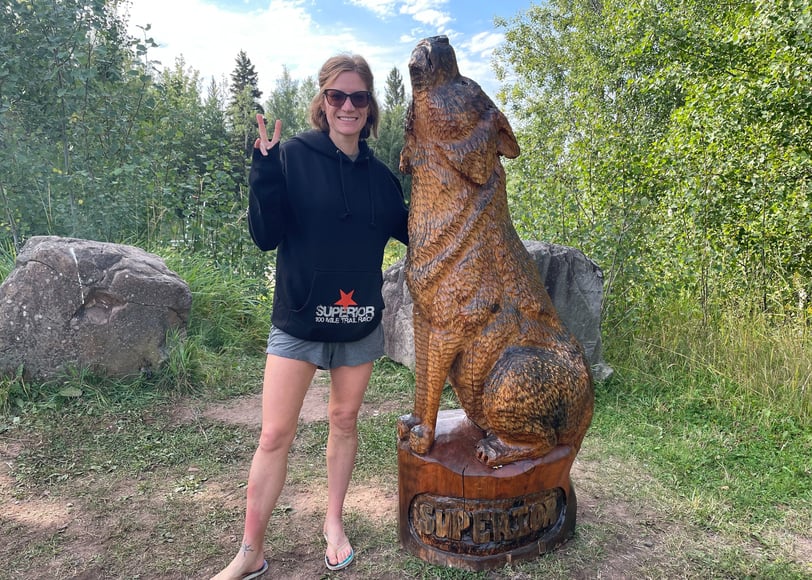

It’s so much fun to talk about races. The adventure. The effort. The emotions. The overcoming. What’s less fun to talk about is the recovery. As I write this, it has been just over 9 weeks since running my first 100 mile ultra, and I’m still not 100%. In fact, I would put myself at around 80-90% at best. Sure, I anticipated needing some time to return to baseline, but I wasn’t expecting it to take this long. I tend to bounce back from races fairly quickly. After my first 100k, I was running around Arches National Park just a few days later with relative ease. I thought for sure within a few weeks of the 100 miler I’d be tackling longer distances again. Boy was I wrong.
Now, I know everyone heals differently, and recovery can look very different depending on fitness level going into the race, the type of race it was (ex. technical, hilly, flat), previous injuries, etc. But after this race, I found myself wanting to hear more about others’ recovery process. How long it took. What types of treatment modalities they used. When they started exercising again. How they eased back into the miles. I figured I’d share my experience with the world in the event that it may help someone at least feel validated if their recovery is taking as excruciatingly long as mine.
Let’s start from the beginning. While I felt well trained, the race I chose was extremely technical with a lot of climbing (about 18,000 feet). If you want to read more about that adventure, check out my blog post about it. Unfortunately, I started experiencing a sharp pain in my right shin at mile 62. I then continued to run through that pain as it progressively worsened over the next 40 miles, which took about 16 hours. The worse it got, the more my left side needed to compensate, and eventually I was running (well, mostly hiking) on two bum ankles for far too many hours. I remember thinking to myself, gosh, I really hope I am not causing permanent damage here.
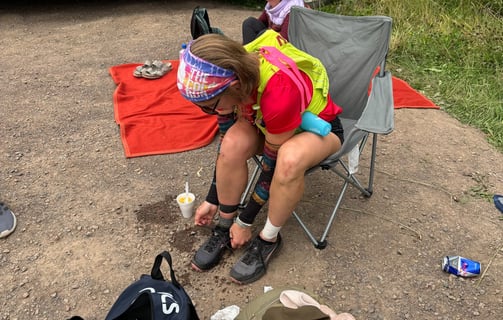

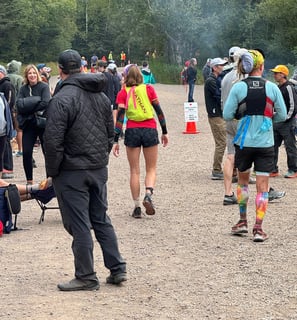

Makeshift ankle wraps and hobbling towards the bathroom at the last aid station.
When I finished the race, the skin on my right shin where the injury initiated was beginning to display a splotchy redness. I went to the medical tent to get it checked out. It wasn't warm to the touch, so they weren't concerned about cellulitis. And I wasn’t in excruciating pain when I wasn’t using it, so they weren’t concerned about compartment syndrome. Ice, ibuprofen, and rest, they recommended. If it gets worse, go get it checked out.
I hobbled my way back to the hotel room and it took everything I had to lower myself into a hot bath to rinse off the past 36 hours of wilderness. I had skeptically hoped the hot water would help settle down the inflammation. It didn’t. When you’re hurt that bad, a tub soak is like using essential oils to get through oral surgery. It’s just not gonna cut it. But I enjoyed it nonetheless, it was a relaxing way to close out the day before crashing in bed.
Or at least, I had thought I would crash. After being awake for 2 days and moving nonstop, you’d think your body would just shut down, right? Apparently not when you are in so much discomfort you are physically unable to block out the sensations running through your body. I did fall asleep quickly, and it lasted for probably two hours or so, but then I awoke to the most extreme case of restless legs I’ve ever experienced. I simply couldn’t lay still. If I stopped moving, the throbbing would reverberate up and down my legs and into my torso. The only way to find relief was to move. And it’s pretty hard to fall asleep while you’re moving.
Eventually I had to use the bathroom. I fumbled through the dark hotel room, legs stiff as two by fours. I stared at the toilet for a good 10 seconds. I have to sit down on you, I thought. It felt like minutes before my cheeks met the toilet seat. And then, I suddenly felt an intense wave of sickness rush through my guts. I quickly (well, as quickly as I could) got myself off the toilet to prepare for something to come out the other end. I was dizzy and nauseous, saliva pooling in my mouth like it does when you’re ready to vomit, but nothing came out. I laid down flat on my back on the cold bathroom floor and closed my eyes, waiting for the sensation to pass. Thankfully it did, and I managed to pull myself up off the floor and find my way back to my bed. This is the price we pay to do cool shit, I thought as I continued to navigate the discomfort.
I don’t know how long I spent turning myself over and over in that bed, stomach to side to back to stomach to side to back, over and over and over again. But I eventually fell back asleep and awoke what felt like minutes later to Elliot’s soft kisses on my cheek. I didn’t want to get up, but I knew I had to. We had to check out of our hotel by 11am and I wasn’t moving quickly. I immediately examined my right shin. The redness had now spread up towards my knee and was becoming more prominent. This isn’t good, I thought. But it still wasn’t warm, and it only hurt to walk on, so I did my best to stay calm and sent a pic to my chiropractor to get his take on it. He is an incredibly intelligent man who has a dual degree as a PT and lots of experience with athletes. I trust his judgement more than anyone when it comes to caring for my body. He sent me a few thoughts on what it could be, but felt the most likely diagnosis was rhabdomyolysis, something that is pretty common in the ultra running community. Severity of it, however, can make a difference as to the symptoms experienced and how quickly one recovers. He still recommended I get it checked out at an orthopedic urgent care, just to rule out any fractures.
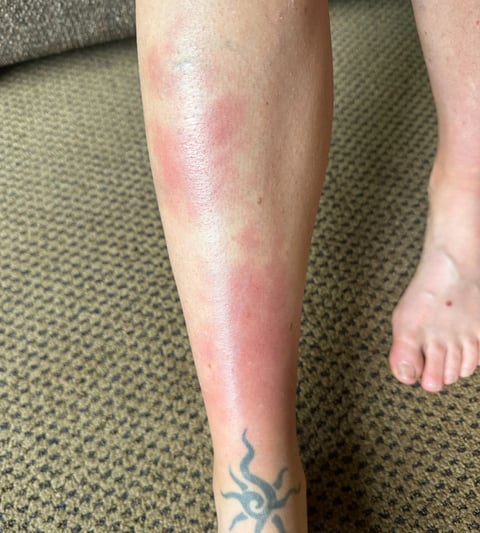

The morning after the race, waking up at the hotel.
The three hour drive home was nearly as challenging as laying still in bed. This is really the last leg of the ultra, I thought. I watched the redness on my shin get worse and worse as we drove. I’ll admit, I was pretty nervous. I hadn’t heard of anyone else experiencing anything quite like this. I had no idea what was going on and what it meant in the long term. But I couldn’t dwell on the unknown, I had to focus on what I could control. As soon as we got to the house, we unloaded the vehicle and I got right back in it to head to Twin Cities Orthopedic.
Luckily, the wait wasn’t too long. I sat patiently in the lobby with ice packs on my increasingly reddening shin, elevating both legs to help alleviate the swelling in my ankles. When I was called in, I made my way slowly to the exam room behind the physician’s assistant. My favorite part of the visit was the look on the young man’s face when I explained to him what had happened. 100 miles? Like, all at once? On the Superior Hiking Trail? The typical questions you get from folks who are unfamiliar with the ultra world. He judiciously took notes before calling in the gentleman who would be examining me, which came with another round of questioning and disbelief.
I don’t think they knew what to do with me. He also brought up cellulitis and compartment syndrome, and also didn’t think they were the issue. I proposed rhabdo, which he hadn’t considered, but thought it was a reasonable diagnosis. He poked and prodded a bit, and the best he could offer was a boot. I tried one on and the pain only intensified. My chiro also strongly recommended against this option (we were texting while I was in the exam room). I’ll pass, I said. On the bright side, the images didn’t reveal any fractures. I was likely just severely inflamed with significant muscle damage. Ice, ibuprofen, light ACE wrap, rest.
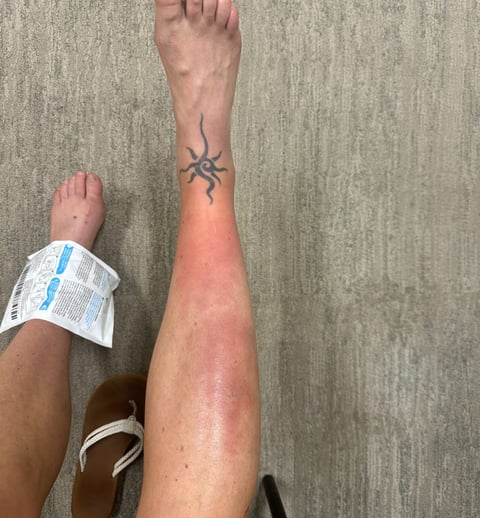

Waiting to be seen at urgent care, watching the redness progress.
With that background, here’s a recap of the 9 weeks that followed:
Day 1 post-race: The redness progressively worsened throughout the day and both ankles were incredibly swollen. I was able to ambulate on flat ground without assistance, albeit very slowly. Stairs definitely required a railing to grab onto. I woke in the middle of the night that evening in such excruciating pain I could not move my leg at all and I was fighting back tears. I called Elliot on the phone (I was in bed, he was downstairs in the living room) and asked him to bring me some ibuprofen and a walking stick to help me ambulate through the house.
Day 2 post-race: The redness began to subside and appeared more like bruises. The swelling in my ankles was still significant, and my shins and ankles were tender to the touch. I used my walking stick to help me get around the house and up and down the stairs.
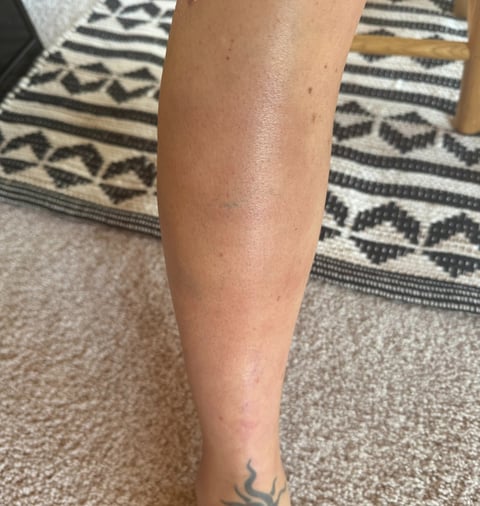

Day 2, looking much better.
Day 4 post-race: After 3 full rest days, I did 20 minutes of light indoor cycling per my chiropractor/PT’s recommendation. It felt great, no pain, but I was still incredibly fatigued in my legs. I secured a sub to teach my BodyPump class, I was definitely not ready to teach yet. I started incorporating ankle pumps throughout the day to keep things moving and maintain as much flexibility in my ankle joints as I could (also doctor’s orders).
Day 6 post-race: Typically on Fridays I’d be running a 5.25 mile loop with my Andover Run Club. Knowing I wasn’t ready yet, I opted to bike with them instead. I embraced the easy ride while they all pushed pace, as they do. I enjoyed the fact that I could hang with the fast group and chat without feeling winded.
Day 7 post-race: I felt ready to take on a longer bike ride, and tackled 16.71 miles at an easy pace to explore our local sunflower field. Although my legs were still jelly-like, the effort felt good and didn’t aggravate my ankles at all. In fact, it felt productive to flex and dorsiflex my foot for an extended period of time.
Day 8 post-race: With the previous day’s ride going so well, I decided to do another 15.21 miles, which also went well.
Day 9 post-race: I usually transition to heavy lifting about this time of year. It was middle of September and all of my races for the year were done, it was time to start. Today was day 1, and I stuck with upper body exercises only. Chest press, biceps, triceps, and back lifts working in the 8-10 rep range.
Day 10 post-race: I attempted my first run since the race. I wasn’t sure what to expect, so I started with a mile and it felt decent, so I did another. I wasn’t experiencing any pain, so I decided to snag one more for a total of 3.12 miles. Overall it went really well, but the numbness in my left ankle felt super odd. My feet were also still clearly swollen, making my shoes fit tighter than usual.
Day 11 post-race: I was able to get back to teaching BodyPump. Squats felt surprisingly good, I just kept my weight a little lighter than usual. Everything else felt great too, with the exception of lunges. I couldn’t hit full range without feeling a sharp pain shoot through my shins.
Day 13 post-race: I was still experiencing pain in my ankle when walking too much in my flats at work. I was still wrapping with ACE bandages occasionally. As such, I wasn’t comfortable running yet, and swapped out another Friday run club run with a bike ride.
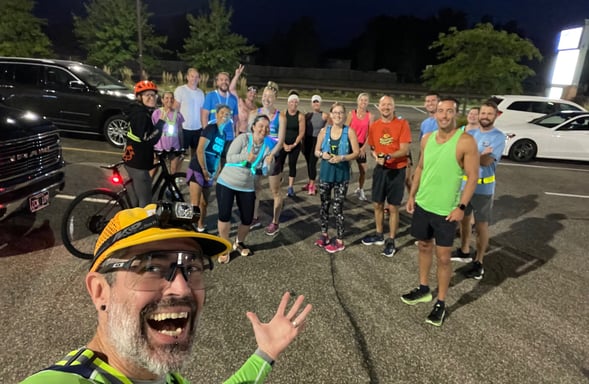

Friday morning run club, making the most on my bike.
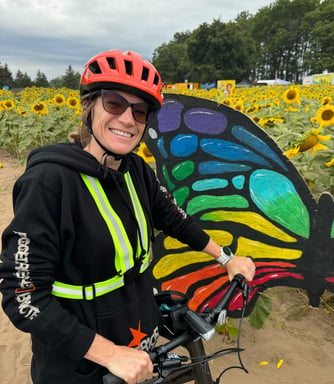

Exploring the sunflower fields.
Day 14 post-race: Heavy lifting day and I felt ready to try lower body exercises. I was still fairly conservative with my weight and could have done more than 8-10 reps, but wanted to ease my way into it. I was delighted to have no issues with squats or deadlifts. I also snuck in a 5.5 mile bike ride later in the day.
Day 15 post-race: I was still nervous about running, so I went to the YMCA to use the elliptical. When I accidentally arrived 30 minutes before they opened, I decided to just give it a whirl. I threw down 3.25 miles at an easy pace and felt surprisingly good, but I didn’t want to push it. I finished my workout with 30 minutes on the elliptical. I can confidently say that is the first and last time I will ever use one.
Day 16 post-race: With feeling so good on my run the day before, I decided to give it another try. I kept the pace easy at first, but then things started feeling really good. My last full mile was sub 8 minute pace, and the last quarter mile was sub 7 minute pace. I’m back! At this point I felt good about mixing running back into my weekly routine 2 to 3 days per week.
3 weeks post-race: I was badly craving a longer distance and felt ready for it. I decided to try a 10 mile run with Elliot and a friend of ours. It was a bad idea. It wasn’t my ankles, but my hips that were completely destroyed. I could barely lift my legs to go upstairs for a couple days after that run. I had to take a few days off from running. I started incorporating more yoga and walks, continued with heavy lifting, and decided to keep my running distance to a max of 5 miles.
4 weeks post-race: More of the same. Still limiting runs to 3 days per week and a max of 5 miles. Still unable to lunge normally at BodyPump. Still numb through my left ankle. Still seeing my PTA once a week to get worked on.
6 weeks post-race: I got out for my first trail run since the race, and decided to test a longer distance again. We did 7.5 miles and it felt pretty good, but my hips were talking to me throughout the second half. It wouldn’t have been wise to push it any further. On the bright side, the pain in my hips post-run was not as severe. And, I was finally able to hit full range with my lunges!
9 weeks post-race: I’m still experiencing hip pain after runs longer than 5 miles, but it is not as severe and subsides more quickly. I usually can’t feel it the next day. I still have deep muscle and tendon injuries in both ankles and shins and continue to see my PTA and/or chiropractor every week. While I am fortunate that they are not symptomatic while I run, I am still nursing them as best I can as I want to be fully recovered before training season ramps back up. I’m still experiencing numbness in my left ankle, but from what I understand that could take months to fully go away. I continue to incorporate yoga and PT stretches into my (nearly) daily routine. I continue to prioritize lifting since it’s my off season for running, and it continues to feel great.
I may have to come back and add to this post later because the reality is, I’m not fully recovered yet, and I’m not really sure when I will be. I guess this is another element of the unknown when taking on a race of this caliber. It’s a discovery process. I am learning new things about my body. How it responds to 100 miles, and how to best manage it post race. I’m thinking about how I can train differently to prevent a similar injury at the next one. I’m practicing patience and grace as I wait to be able to perform the way I used to. I’m by no means an expert, but as I reflect on my experience, here are my key takeaways:
PT and chiropractic care have been critical to my recovery (not just post race, but all year round). I am beyond grateful for such an amazing care team at IOC to help put me back together. I also know I get the best results when I am religious about doing my prescribed stretches daily. As boring and redundant as they are, they work!
Patience really is a virtue. I enjoyed taking it easy, at first. But as someone who is used to exercising every day, it became very difficult to take full days off. I know it is what my body needed at times, but I struggled to do nothing. I may have slowed my recovery by pushing too hard too quickly, or being active on days that I should have rested.
Although I may have worked out when I shouldn’t have, I really did do my best to listen to my body and respond to the feedback I was receiving from it, adjusting my workouts accordingly. This helped ensure that the set backs were few and not significant.
Cross training was a really fun way to stay active and keep it low impact. Biking was my favorite. Walking and yoga were next in line. The elliptical can go to hell.
I found that things started improving more quickly when I started using arnica oil and sublingual tablets. I didn’t start using them until about 7 weeks post race, so it may have been that I happened to hit a turning point at that time. Nevertheless, I plan to start using it earlier next time as it is a low risk homeopathic option and may help speed things up.
I was more disappointed about the length of my recovery because my reality did not match my expectations. I thought for sure I’d be crushing half marathons in a few weeks. Not even close. I will now approach recovery with an open mind, take instruction from how my body feels, and focus on using the time to enjoy other things (like starting a blog).
It may not be worth it to push through an injury. I need to seriously consider the long-term effects of doing so, and if getting to the finish line is worth potentially being unable to get back out there to do it again. That said, in this particular case, I’d do it all over again in a heart beat. It was totally worth it.
So, there you have it. My recovery journey in process. It hasn’t been pretty. It hasn’t been fun. But I’ve learned a ton and I hope you gleaned some insight from it, too!
Update: I am now just shy of 4 months post-race and finally feeling (mostly) back to normal. The numbness in my left ankle is soooooo close to being gone. My hips were not painful for my last few 7+ mile runs. I even got up to 14 miles on my last one, pushing pace, with no issues. It feels great to be getting back to some level of normalcy, especially since it is time to start training for Boston! And, Elliot and I just received confirmation that we were selected to run Superior again in 2025 :). Cheers to a new year of challenges!
